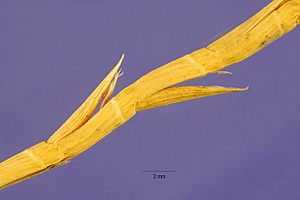Hainardia facts for kids
Quick facts for kids Hainardia |
|
|---|---|
 |
|
| Scientific classification | |
| Genus: |
Hainardia
|
| Species: |
cylindrica
|
| Synonyms | |
|
|
Hainardia is a type of plant that belongs to the grass family. These plants usually grow near the coast. They are found naturally around the Mediterranean Sea.
The only known species in this group is called Hainardia cylindrica. It has a few common names like barbgrass or thintail. This plant is originally from the Mediterranean region. It also grows in nearby areas, from Madeira and the Canary Islands all the way east to Crimea and Iran.
You can also find Hainardia cylindrica growing in other parts of the world. It has spread to coastal areas in Australia, New Zealand, and the United States. In the U.S., it's found in states like CA, OR, TX, LA, and SC. It also grows in Baja California (Mexico) and some temperate parts of South America, including Brazil, Uruguay, Argentina, and Chile.
What is Hainardia cylindrica?
Hainardia cylindrica is an annual grass. This means it completes its entire life cycle within one year. It grows best in salty or alkaline soils. You can often find it in salt marshes and estuaries, which are places where rivers meet the sea.
How it Grows
This plant has a stem that can branch out. It can grow up to about half a meter tall, which is about 20 inches. Its leaves are thin and have ribs. If you touch the top of the leaves, they feel a bit rough.
The top part of the stem, a few centimeters long, forms a special structure. This structure is a cylindrical inflorescence. An inflorescence is a group of flowers arranged on a stem. In this plant, each tiny flower cluster, called a spikelet, is tucked into the cylinder. This makes the cylinder break into small segments.
Where it Lives
This plant is a halophyte. This means it is specially adapted to grow in very salty conditions. It thrives in places where most other plants would struggle to survive because of the high salt content in the soil or water.

